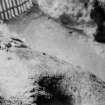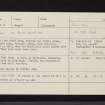Pricing Change
New pricing for orders of material from this site will come into place shortly. Charges for supply of digital images, digitisation on demand, prints and licensing will be altered.
Upcoming Maintenance
Please be advised that this website will undergo scheduled maintenance on the following dates:
Thursday, 9 January: 11:00 AM - 3:00 PM
Thursday, 23 January: 11:00 AM - 3:00 PM
Thursday, 30 January: 11:00 AM - 3:00 PM
During these times, some functionality such as image purchasing may be temporarily unavailable. We apologise for any inconvenience this may cause.
Ellary Farm
Cave (Period Unassigned), Midden (Medieval), Occupation Site (Iron Age), Microlith(S)
Site Name Ellary Farm
Classification Cave (Period Unassigned), Midden (Medieval), Occupation Site (Iron Age), Microlith(S)
Alternative Name(s) Ellary Cave; Ellary Boulder Cave
Canmore ID 39032
Site Number NR77NW 12
NGR NR 7392 7649
Datum OSGB36 - NGR
Permalink http://canmore.org.uk/site/39032
- Council Argyll And Bute
- Parish South Knapdale
- Former Region Strathclyde
- Former District Argyll And Bute
- Former County Argyll
NR77NW 12 7392 7649.
(NR 7396 7648) Cave, between two rocks; roomy, walled both ends, entrance steps, deep deposits. Examined in 1961, when two Mesolithic micro blades were found. They have since been lost.
M Campbell and M Sandeman 1964.
NR 7395 7649: A cave, as described, measuring 6.5m by 4.0m by 2.0m high. Inside, the excavation trenches are still visible.
Cave visible on air photograph 72/084: 046.
Visited by OS (DWR) 14 June 1973.
NR 7393 7650. No change to the report of 14 June 1973.
Surveyed at 1/10,000.
For nearby rock shelter see NR77NW 31.
Excavated by C Smith 1987-8.
Work in 1987 indicated that although this site had suffered considerable disturbance the western portion of the main chamber might preserve intact deposits. Two weeks excavation in May, concentrated in this area, has established that this is the case.
Stratified deposits excavated to date extend to a depth of 0.8m below the cave floor and probing has indicated that at least a further 0.4m remains to be excavated. These deposits appear to dip gently towards the west and continue below a massive rubble talus which partly blocks the western entrance.
The excavation proceeds by context but for recording purposes a 0.5m grid is employed. All stratified finds are wet-sieved and hand-sorted on site except for a small portion which is retained for fine sieving and flotation. In 1988 it proved possible to recover flint spalls as small as 5mm using the equipment and procedures available. All the main deposits so far excavated have been sampled for pollen analysis. Preliminary indications from finds recovered in 1987 and 1988 are that three main periods of activity are represented in the deposits so far excavated:
- intermittent activity during the mIddle Ages and post-medieval periods, perhaps by travellers using the old road to Kilmory which passes by the site a few metres further up the slope;
- use during the Iron Age for smelting as indicated by slag, furnace bloom and pottery,
- a period of Neolithic/Late Mesolithic activity indicated by pottery and stone tools of quartz, flint - including a leaf-shaped point - and pitchstone from the Isle of Arran.
These finds of apparently 5th millennium BP date were made during the final days of the 1988 season and most of the deposit from which they came, context (25), is still to be excavated.
C Smith 1989.
The excavations continued in Spring 1989. A further 0.30m of stratified occupation deposits was removed exposing several features including a substantial stone-lined fireplace. Finds were rather more numerous than in previous years and the assemblage of struck flint now numbers several hundred items while the total of worked pitchstone fragments stands at approximately fifty. Animal and fish bones continue to be common finds while shellfish remains are abundant. Post-excavation analysis of biological material is under way and three samples from stratified contexts have been submitted for radio-carbon dating; the results of which are as follows:
Shellmidden Patella 840 +/- 50 BP
L litorrea 1150 +/- 50 BP
Stone lined hearth Charcoal 2100 +/- 50 BP
When allowance is made for the fact that dates on marine molluscs are usually considered to be several centuries too old due to the effects of Carbon-14 in sea water, the two midden dates imply that this deposit was accumulating during the late Middle Ages. This provides a temporal context for the medieval finds recovered from the cave. The charcoal deposit from the hearth is clearly of Iron Age date and it is likely that the evidence for iron working associated with the hearth dates from this period. As yet the earliest activity in the cave, represented by flint, quartz, pitchstone and pottery remains undated.
C S Smith 1991.
Field Visit (May 1983)
Two Mesolithic flints, since lost, found in 1961 in a cave 'with deep deposits' situated some 570m N of Ellary, may be an indication of early occupation of the site (Campbell and Sandeman 1964).
Visited May 1983
RCAHMS 1988












